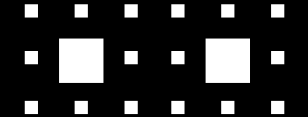A note about multiple-dynamic materials,
also known as meta-materials
One should interpret meta-materials not as "materials of materials" but rather as materials featuring multiple dynamics1.
When designing this material, one tries to benefit from :
- • the visco-thermal dissipation of the porous material
(the foam, fibrous or granular material...), - • the multiple scattering effect
(i.e. an additional effect which brings extra dissipation effect).
One one hand, the efficiency of the visco-thermal dissipation depends on the ratio between the acoustic wavelength and the pore size (or on the ratio between the viscous and thermal boundary layers and the pore size). This dissipation is of interest in a given frequency range only.
One the other hand, the multiple scattering effect depends on the ratio between the acoustic wavelength and the size of the scatterers. The acoustic dissipation associated with this scattering effect is also of interest only in a given frequency range.
Combining the two dynamics, one ends up with a material offering a sound dissipation in a larger frequency range than the porous alone or the scatterers alone.
The list below gives some examples of phenomena which can be added to the visco-thermal dynamic of usual porous materials to improve their behaviors in the case of acoustic excitations. The related frequencies of interest for these additional effects are also reported.

quater-wavelength resonators, around the resonance frequencies,

Helmholtz resonators, around the resonance frequencies,

scatterers, around Rayleigh's scattering frequency,

double-porosity materials (or more generally : materials with multiple scales of porosity), around the pressure diffusion frequency(ies).
Some other phenomena are listed in the slides of a talk given during ICA 2019 in Aachen (Germany) and in a proceeding of the SIA NVH Comfort conference held in 2021 in Le Mans (France). References of experimental and modeling works are also reported in these 2 links.
The list above does not include active structures with "diode" effect (requiring a flow) or black holes3, i.e. retardant structures (which are functionally graded materials i.e. non-homogeneous materials).
These latter phenomena might fall in other material categories (such as active materials and non-homogeneous materials).
Finally, one has to keep in mind that Periodicity adds Bragg interferences but is not necessary to take advantage of other phenomena. Materials for which the main involved phenomenon is Bragg interferences are usually called phononic crystals.